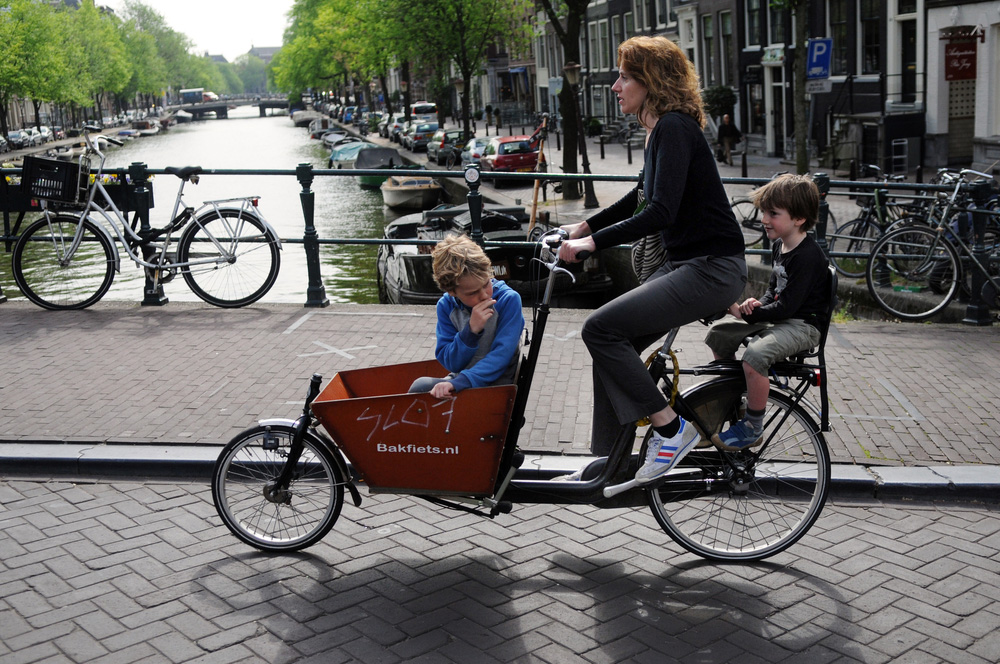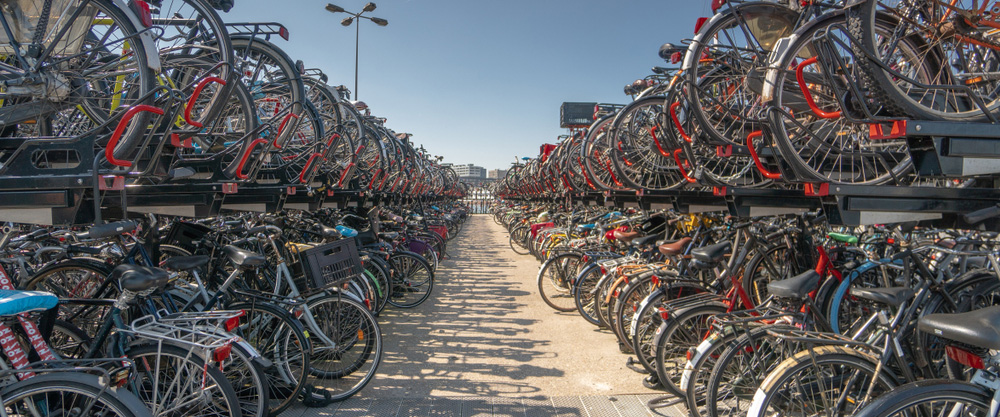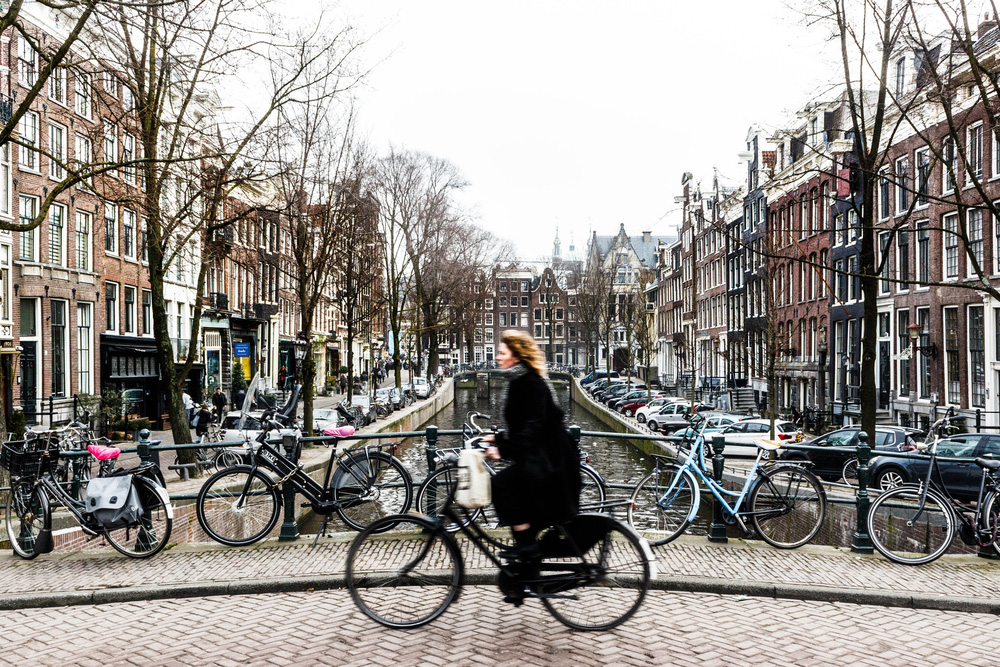A few minutes in a bakery on Amsterdam’s Albert Cuypstraat taught me a lot about how far Vancouver has to go in developing a sensible system for moving people around.
Over a superb chocolate croissant and coffee like straight molten caffeine, I watched the locals heading for work and school on a rainy Friday morning. The street isn’t especially wide, but it has room for cars, tram tracks and dedicated lanes for bikes, mopeds and scooters.
Amsterdam cyclists are different from Vancouver’s. I saw little spandex and few racing bikes; people on ordinary sit-up-straight bikes, wearing ordinary clothes, were moving at high speed amid pedestrians, scooters and cars. Some rode specialized bikes with compartments for their kids, while other kids sat behind their dads. Many cyclists talked or texted on their phones. The only helmet I saw that day was an iron one, on display in the Rijksmuseum.
Amsterdam and Vancouver are roughly comparable in terms of population. Amsterdam’s population density is 5,100/square kilometre and ours is about 5,500/square kilometre. Amsterdam proper has a total population of 850,000, and 2.4 million live in the metro region. Vancouver city has 630,000 and 2.4 million in the metro region.
More bikes than people
Amsterdam actually has 1.2 million bikes, a statistic that seems improbable until you see them in thousands on the sidewalks — which are wider than ours precisely to make parking space for bicycles. (In Amsterdam's south station, I saw an underground bike parkade.)

Maybe the Dutch newspapers are full of drivers’ complaints about bikes hogging the roads, but I saw no sign of hostility. Bikes, scooters, mopeds, cars, buses and trams all functioned smoothly together. Pedestrians (voetgangers in Dutch) routinely checked left-right-left before venturing across the street.
As in Copenhagen, Amsterdam’s cyclists enjoy the advantage of a flat terrain. But they’ve also built the bike into their culture as a common-sense solution to the problem of getting around.
Common sense is also at work in the rest of the transportation system. When my wife and I caught a cab from Amsterdam’s central train station to our hotel, it was a Nissan Leaf; the driver told us that by 2020 all taxis serving the train station and Schiphol airport will have to be electric.
That’s just part of Plan Amsterdam, a document so sensible it seems impossible to imagine as a Plan Vancouver.
Significantly, Plan Amsterdam is more interested in improving air quality than in fighting climate change:
“Focusing on the health benefits of cleaner air, the city decided to set a target: to create more space for cyclists and pedestrians, to promote clean transport and achieve zero emissions by 2025.… As well as the ambition to improve air quality, this agenda also provides targets with regard to sustainable energy, a circular economy, a climate proof city and making the city more sustainable.”
Subsidize what you want, tax what you don’t
Operating on the principle of taxing what you want less of and subsidizing what you want more of, Amsterdam offers big purchase subsidies to companies that switch their cars, trucks and taxis to electric: “Fully electric taxis, company cars or delivery vans receive 5,000 euros [C$7,609] per vehicle, while for plug-in-electric lorries and buses up to 40,000 euros [C$60,874] per vehicle is available.”
What’s more, electric cars can park free at the city’s numerous charging stations, as long as they’re connected, and such cars also get priority for residential parking permits (which normally take years to obtain). The charging stations, which began to be installed in 2009, helped trigger the growth in electric cars; they’re powered by the wind turbines around Amsterdam harbour.
Car sharing is a natural fit for electric vehicles. Plan Amsterdam cites Car2go, which went 100 per cent electric to take advantage of the city’s park-anywhere policy. That in turn encouraged Nissan, BMW and Tesla to launch new electric-car models in Amsterdam, while numerous other electric-mobility companies have set up shop in the city as well.
Starting this year, Amsterdam city council and public transport company GVB are replacing some 200 buses; by 2025 the whole bus system will be emissions-free. The city’s 4,000 taxis run mostly on diesel and “on average they emit 35 times more hazardous emissions than an average petrol passenger car.… all taxis should be fully emissions-free by 2025. The Clean Taxis for Amsterdam Covenant has been signed by all licensed taxi companies in Amsterdam.”
The push to clean air goes all the way to smaller vehicles: “Although Amsterdam aims to reduce traffic in the city centre,” the report says, “in recent years the use of most types of vehicles has increased. Moped traffic has almost doubled, showing an increase of 91 per cent between 2008 and 2014. Recent research by Dutch science institute TNO confirmed suspicions raised by previous research: mopeds emit pollutants which are hazardous to health; emissions which can be anything between 10 to 100 times higher in mopeds than in passenger cars and which are directly inhaled by pedestrians and cyclists.” So by 2025 scooters and mopeds will also have to go electric.

By comparison, Canadian efforts at going emissions-free seem more aspirational than practical. We know perfectly well that air pollution kills 21,000 Canadians every year, yet Ottawa still wants to pump more diluted bitumen to tidewater.
Electric vehicles have barely made a dent in the Canadian market, and public transit, especially in the Lower Mainland, still relies chiefly on diesel-belching buses. Having abandoned the old streetcar system long ago, we now quarrel about whether car-choked Surrey should go with more SkyTrain or with light rail transit.
In effect, our thinking is as constrained by our car-centred infrastructure as the traffic itself. Spending what it would take to rebuild that infrastructure — tramlines, bike lanes, bike and scooter parkades, wind turbines — is politically impossible. So we prefer that 21,000 other Canadians pay the full price for our present toxic transportation system, year after year.
Unless we’re willing to study the Dutch and other European transportation systems, and to pay the price of emulating them, no one in a Vancouver bakery is likely to see traffic moving as smoothly and cleanly as it routinely does on Albert Cuypstraat and countless other Amsterdam streets. ![]()
Read more: Transportation, Urban Planning + Architecture

















Tyee Commenting Guidelines
Comments that violate guidelines risk being deleted, and violations may result in a temporary or permanent user ban. Maintain the spirit of good conversation to stay in the discussion.
*Please note The Tyee is not a forum for spreading misinformation about COVID-19, denying its existence or minimizing its risk to public health.
Do:
Do not: